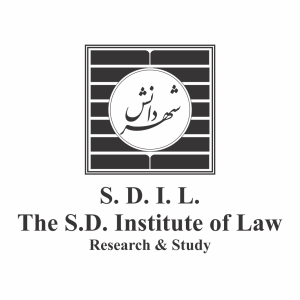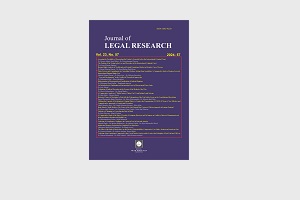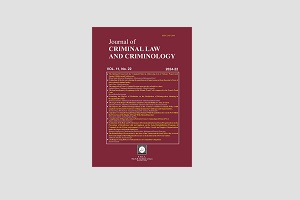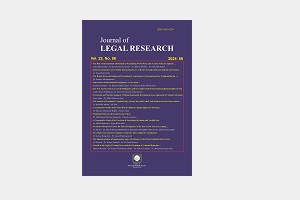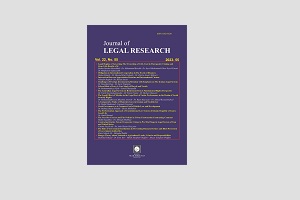Journal of
LEGAL RESEARCH
Number 42
Vol. XIX ● No. 2
Summer 2020
Managing Editor: Vahid Eshtiagh
Editor-in-Chief: Seyyed Ghasem Zamani
CONTENTS
Articles
Elements of Iranian First Constitution; Principles of the Rule of Law
Dr. Seyyed Naser Soltani
The Provision of Fundamental Principles and Rights at Work
Dr. Zohreh Rahmani
An Analysis to the Conceptual Development of Culture in International Human Rights Law and Its Impact on the Promotion of Cultural Rights
Dr. Mostafa Fazaeli & Mousa Karami
The New Approaches to Determine Competent Courts in Relation to the Intellectual Property Claims in the Private International Law
Niloufar Nazaryani
Dynamic Jurisprudence and Conflict Settlement of the Islamic Republic of Iran with International Conventions on the Prohibition of Executions of Individuals for Crimes Committed bellow the Age of 18
Amirhossein Mohebali & Ali Orooji & Zahra Imani
Jurisprudence of European Court of Human Rights on Elimination of Religious Intolerance
Siavash Sadeghpoor & Dr. Ehsan Javid
Consideration of the Need to Reflect the Contents of the Bills of Exchange on the Bill
Ali Bozorgpour & MohammadJavad Manavi Attar
Rules Governing the Examination of Documents in the Law of Documentary Letters of Credit
Mahsa Lesani & Dr. Said Shojaei Arani
The Role of Implies the Obligation in Determining the Range of Legal Obligations for Physicians and Medical Institutions
Ali Khaledi
The Study of the Status of Wife’s Alimony for Realize Social Justice
Dr. Raheleh Kardavani & Mahdi Vakili
Justice Victimology on the Basis of Labeling Theory and Methods to Prevent It
Tahmineh Shahpuri & Mohamad Matin Parsa & Dr. Nabiollah Gholami
Explaining Specific Criminal Description Model: to look to Paragraph 1 of Article 1 of the Punishment Law of Disruptors in the Economic System
Seyyedeh Tahereh Khabbazi Khaddar & Dr. Seyyed Hossein Hosseini
The Impact of Protecting Industrial Property Rights in the Realization of Resistance Economy
Meysam Esmaeili Yadaki & Dr. Zahra Shakeri
Disciplinary Responsibilities of Judges in Common Law Legal Systems: A Comparative Study in the Contexts of USA, England, and Canada
Dr. Azadeh Abdollahzadeh Shahrbabaki
Review the Right of Environmental Regulations to Take Precedence over the Anfal Analysis Order
Dr. Mohammad Masoudinia
Deliberations about Innovations of Dispute Resolution Council Law Approved in 1394
Marzieh Ghorbanpour & Dr. Saleh Yamrali
Analysis of Pink Collar Crime Article: Women and Crime at Work
Author: Margaret Hammond
Translators: Maryam Kamaei & Dr. Salameh Abolhasani
Articles
Elements of Iranian First Constitution; Principles of the Rule of Law
Dr. Seyyed Naser Soltani
Assistant Professor, Department of International Law and Public Law, Faculty of Law, College of Farabi, University of Tehran, Qom, Iran
Abstract: The constitutionalism idea in Iran has a historical background and battle against arbitrary since many years ago considerable efforts have been made in this respect. Since the introduction of Constitutional Vision as one of the most important tools for bounding the extreme powers of the government in all over the world, this issue became prevalent in Iran as well. Amir Kabir and Sepahsalar were the first people in Iran who tried to write a constitution and the constitution as a device to beat against despotism has attracted their attention. Although Amir Kabir’s attempts failed due to the fact that he was murdered, they were followed by other people and the first draft of Constitution was provided thanks to attempts of Yousef Khan Mostashar al-Dowleh. In spite of the marginal principles indicated in the draft by authors, they could act as an overture to further efforts and contributions. Noting the concepts of constitution and principles of the rule of law indicated by the authors can contribute to a better understanding and recognition of these concepts. A number of concepts included in the passage need more elaboration and moreover, the passage points out some of the historical concepts of Persian Constitution Revolution which have not been well-investigated in the current Constitution of Iran. Exploring this heritage and its reflections in the constitutional courses is considered as one of the ways to develop and extend Constitution of Iran.
Keywords: Constitution, Sharia, Trust, Constitutional History.
The Provision of Fundamental Principles and Rights at Work
Dr. Zohreh Rahmani
Assistant Professor of Department of Law, Islamic Azad University, Bandar Anzali Branch, Gilan, Iran
Abstract: The discourses related to labour law like any other approach of human rights requires design a theory about rights that emphasizes on legal and moral necessity and justifying the existence and value of fundamental principles and rules of work, specially in some important and effective scope in life and basis of labour law such as elimination of discrimination in respect of employment and occupation, equal remuneration, abolition of forced labour, right to collective bargaining negotiations and freedom of association. The fact that the criteria of labour law to what extent is a part of human rights, is a discrepant and challenging issue, but certainly, content and context of fundamental conventions of work clearly represents principle and criteria of human rights and because of this, all members even if they have not ratified the convention in question have an obligation to respect and perform it.
Keywords: Fundamental Rights of Work, Elimination of Discrimination of Employment, Equal Remuneration, Abolition of Forced Labour, Freedom of Association and Collective Bargaining Negotiations.
An Analysis to the Conceptual Development of Culture in International Human Rights Law and Its Impact on the Promotion of Cultural Rights
Dr. Mostafa Fazaeli
Associate Professor of International Law, Department of International Law, Faculty of Law, University of Qom, Qom, Iran
&
Mousa Karami
Ph.D. Candidate in Public International Law, Faculty of Law, University of Qom, Qom, Iran
Abstract: The present article, in a descriptive-analytic method and on a library-based approach, aims to investigate the conceptual development of culture in International Human Rights Law and its relationship with the promotion of cultural human rights. Culture, as the essence of being human, is central to man and without which no rights are possible. In International Law arena, culture is mostly presented in cultural rights discourse, and various expressions of the concept could be found in different international instrument. This study demonstrates that, from the establishment of UN up to now, the concept of culture has experienced three evolutional interpretations: culture as culture of elites or high culture, culture as popular culture and culture as a way of life. This evolutional process shows the increasing significance of cultural diversity in the contemporary International Law and consequently promotion of cultural rights.
Keywords: Culture, Cultural Rights, International Human Rights Law, Way of Life, Cultural Diversity.
The New Approaches to Determine Competent Courts in Relation to the Intellectual Property Claims in the Private International Law
Niloufar Nazaryani
Ph.D. Student of International Law, Faculty of Law, Shahid Beheshti University, Tehran, Iran
Abstract: Intellectual achievements of humans have been found important place in today world. In early times, law tried to protect the tangible properties but, human’s intangible properties have been increasing high place todays. If these filed claims have foreign factors, it includes in the private international law field and it had been discussed in the legal doctrines so much. International doctrines study this matter in the recent years. This article tries to study different approaches proposed in these documents. One of the approaches proposes that in the certain situations court should refuse the jurisdiction to the claim because of forum non convenience and lack of sufficient connecting factor. However the latest approach recommends that jurisdiction disputes between states should settle with international cooperation and considering other state courts. Role of the sovereignty has been less historically. So, it seems that the second approach is more desiring to the individualism and legal method (contrast to the dogmatic method) has obtained increasing place in the codification of regulation of court’s jurisdiction in the sphere of intellectual property.
Keywords: Intellectual Property Law, Competence Court, Dispute, WIPO, Doctrine.
Dynamic Jurisprudence and Conflict Settlement of the Islamic Republic of Iran with International Conventions on the Prohibition of Executions of Individuals for Crimes Committed bellow the Age of 18
Amirhossein Mohebali
Ph.D. Student in International Law, Faculty of Law and Political Sciences, Allameh Tabataba’i University, Tehran, Iran
&
Ali Orooji
Ph.D. Student in International Law, Faculty of Law and Political Sciences, Allameh Tabataba’i University, Tehran, Iran
&
Zahra Imani
Level Three of Jamea Al-Zahra, Qom, Iran
Abstract: The right to life, in accordance with the International Covenant on Civil and Political Rights, is a non derogable right. Article 4, paragraph 2, of the Covenant considers Article 6 (right to life) to be irreparable. Article 6, of course, does not speak of the absolute prohibition of life annulment and preserves it solely for the most serious crimes and observes the conditions. On the other hand, in paragraph 5, he speaks of the absolute ban on the execution of people under the age of 18 and pregnant women. One of the controversies of the Islamic Republic of Iran with these treaties is the discussion about the minimum age of the child for criminal responsibility and specially execution, which the international human rights documents and bodies consider to be 18 years of age. But our jurisprudents have taken to criminal responsibility for age is 9 lunar years for girls and 15 lunar years for boys. This is all the while, unlike Sunnis, who believe that blocking the Ijthad after the four Imams, the Shi’i jurisprudence is characteristic of dynasties, ijtihad, and the high place of tradition and soul. The jurisprudential reasons regarding the issue of maturity and exodus from a childhood are very diverse and the Holy Quran distinguishes between puberty and growth. So that it can avoid conflicts with a human rights instruments and human rights law and consider 18 years old for understanding the consequences of the crime in case of children.
Keywords: Child Rights, Human Rights Instruments, Dynamic Jurisprudence, Domestic Law, Juvenile Execution.
Jurisprudence of European Court of Human Rights on Elimination of Religious Intolerance
Siavash Sadeghpoor
Master of International Law, Faculty of Humanities, Islamic Azad University, Maragheh Branch, East Azerbaijan, Iran
&
Dr. Ehsan Javid
Assistant Professor of International Law Department, Faculty of Humanities, Islamic Azad University, Maragheh Branch, East Azerbaijan, Iran
Abstract: One of the important achievements of humanity, has been the modernist approach to the concept of religion and its transformation from a full-fledged government policy into a personal inherently faith. The right to freedom of religion is among the fundamental human rights identified and protected in international and regional human rights documents; However, it should be acknowledged that, firstly, due to its quiddity and its legal nature, in the international arena is conditional on the acceptance of the governments, and secondly, the approach of different states towards it, is different depending on the political, social and cultural conditions that govern them. This right in Europe is protected by the European Convention on Human Rights and its collateral entity, the European Court of Human Rights. In this study in addition to reviewing the international obligations of States in the field of the protection of religious freedom, we intend to assess, practice of court in the field of elimination of religious intolerance and determination of territory of the right to freedom of religion. Because religious intolerance is one of the earliest causes of international conflict, the benchmarking of the European Court of Action’s practical approach can be effective in reducing conflicts and promoting international and regional peace and security.
Keywords: Human Rights, Freedom of Religion, Religious Intolerance, European Court of Human Rights, European Convention on Human Rights.
Consideration of the Need to Reflect the Contents of the Bills of Exchange on the Bill
Ali Bozorgpour
Ph.D. Student in Oil and Gas Law, Faculty of Law, Tehran University, College of Farabi, Tehran, Iran
&
MohammadJavad Manavi Attar
Master of International Trade Law Student, Faculty of Law, Shahid Beheshti University, Tehran, Iran
Abstract: Legislators protect bills of exchange such as promissory notes, drafts, and cheques through the ways which are completely different from those for civil documents due to their different nature. This article is aimed to examine whether the separate piece of paper which is attached to the bills of exchange, specifically drafts, is considered as bills of exchange or not and what the legal nature of such an attached sheet is. For example, when the holder endorses a draft through signing the attached paper, is such an endorsement legally acceptable? What are the legal effects of it? Owing to the current approach taken by legislators, it seems that such an endorsement has still commercial nature under some circumstances. This paper hopefully tries to explain the legal nature and effects of such a separate but attached piece of paper by examining various commercial actions that possibly happened on the bill.
Keywords: Endorsements, Guarantees, Bills of Exchange.
Rules Governing the Examination of Documents in the Law of Documentary Letters of Credit
Mahsa Lesani
M.A. in International Trade Law, Faculty of Law, Shahid Beheshti University, Tehran, Iran
&
Dr. Said Shojaei Arani
Assistant Professor of Economic Law Department, Faculty of Law, Shahid Beheshti University, Tehran, Iran
Abstract: Documentary letter of credit which has been described as the lifeblood of the international trade is one of the most common methods of payment and financing in international transactions, due to its special features. In the documentary credit operation, the realisation of the credit depends on compliant presentation by the beneficiary and examination and determination of presentation compliance by the banks, and the phase of checking documents plays a key role in implementation of the said process. The examination of documents by the issuing bank, confirming bank and nominated bank is subject to certain rules and requirements which can be raised under the titles including applying reasonable care, reviewing documents on their face, prescribed time for examination, consistency of documents, additional documents and data and non-documentary requirements. Obviously, the exact identification of rules and regulations governing the examination of documents by banks is of great importance in order to reduce the risk of transactions and stabilize the validity of letters of credit, and causes the beneficiary, applicant and banks not to encounter unjustified non-payment, illegal payment and lack of reimbursement respectively. This article attempts to respond the difficulties and ambiguities in this area on the basis of the Uniform Customs and Practice for Documentary Credits, the International Standard Banking Practice, other opinions and decisions of the International Chamber of Commerce and leading judgments in the case law.
Keywords: Documentary Letter of Credit, Presentation of Documents, Examination Rules, Presentation Compliance.
The Role of Implies the Obligation in Determining the Range of Legal Obligations for Physicians and Medical Institutions
Ali Khaledi
M.A. in Private Law, Shahed University, Tehran, Iran
Abstract: Among the rules governing the civil liability of physicians and medical institutions is the rule of quando aliquis aliquid concedit. This rule, in addition to being the basis for the civil liability of physicians and medical institutions, reflects the range and scope of their obligations.
Physicians and medical institutions, under the consent to treatment granted by the legislation and patients, are obliged to perform their obligations as needed, especially in the field of medical and therapeutic services. According to the rule of quando aliquis aliquid concedit, physicians and medical institutions are permitted to conduct and provide medical and therapeutic services. On the other hand, such permission is granted in a way that includes all principal, legal, customary and natural aspects of the obligation of physicians and medical institutions. In other words, under the above rule, physicians and medical institutions are known as permitted and also, obliged to perform and provide all medical and therapeutic services as needed pre-treatment, during treatment, and post-treatment, and if refuse to do so or cause any damages, are responsible to compensate for losses incurred.
Keywords: Quando Aliquis Aliquid Concedit, Medical Services, Pre-Treatment, During Treatment, Post-Treatment.
The Study of the Status of Wife’s Alimony for Realize Social Justice
Dr. Raheleh Kardavani
Member of the Scientific Board of the Women and Family Research Center, Qom, Iran
&
Mahdi Vakili
M.A. in Jurisprudence and Principles of Islamic Law, Faculty of Divinity, Political Science and Law, Islamic Azad University, Science and Research Branch, Tehran, Iran
Abstract: The alimony in the law of Iran from the teachings of the Islamic religion is the right and duty which is an important part of family relations and is subject to certain conditions regarding different proportions in the family. The institution is about couples’ relationships, a serious financial support from women in the family, in the pursuit of maternity and matrimonial duties, and ultimately, the realization of social justice and it is based on the importance of strengthening the family institution in the view of Islam. Because it brings genuine justice to the law of justice. Due to the importance of this and its issues in the context of legal vacuum and research vacuum in relation to the lack of support for women and social justice, in this paper, through the study of documents and referring to Iranian laws, the comprehensive consideration of the right of marriage to alimony and the design of the vacuum available in this area. In this regard, the definition, characteristics, guarantee of implementation and the factors of the loss of alimony of the wife are mentioned in Iranian civil law and there are some gaps in this regard. Finally, the wife’s alienation status is mentioned in the realization of social justice in Islamic society. The results are: 1) the non-enactment of the law to types of the woman’s duties in the family, the legitimate obstacles which a woman can refrain from claiming under the covenant, the nature of the wife’s right to the property she gives the husband as alimony and Procedures for Proving alimony in Courts Some of the cases are related to alimony laws in Iran. 2- Since the issue of work and income distribution is one of the most important aspects of social justice and the gender effect of natural causes is influential on the amount and manner in which income is earned in society, the “alimony” institution is one of the most important effective and affected by social justice. 3- It is necessary to amend and update the law on “alimony” in line with changes in the lifestyle and position of women in the family and the realization of two-way gender justice.
Keywords: Wife’s Alimony, Obedience, Legal System of Iran, Social Justice, Gender Justice.
Justice Victimology on the Basis of Labeling Theory and Methods to Prevent It
Tahmineh Shahpuri
Ph.D. Candidate in Criminal Law and Criminology, Faculty of Law and Political Sciences, Allameh Tabataba’i University, Tehran, Iran
&
Mohamad Matin Parsa
Ph.D. Candidate in Criminal Law and Criminology, Faculty of Law and Political Sciences, Allameh Tabataba’i University, Tehran, Iran
&
Dr. Nabiollah Gholami
Ph.D. in Criminal Law and Criminology, Faculty of Law and Political Sciences, Allameh Tabataba’i University, Tehran, Iran
Abstract: Today, in most legal systems in the world, victimization accounted large share of studies and has great importance. Accordingly, one of the various studies in victimology is justice victimology that analyzes role criminal justice institute on harm to its clients. The examples of the the subject that can be imposed on all those engaged in procedure are imposition of economic costs, inappropriate behavior of judicial factors. To identify the cause and correct analysis should explain Labeling Theory well known. Based on this theory, when criminal exist that legislators criminalize with arbitrary decisions that varies in time and space, or behaviors that somewhere else is permissible and acceptable. In this article, with analysis of justice victimology, its consequences in terms of labeling theory, its destructive effects on the individual and society and effects of lack of attention has explained.
Keywords: Victim, Justice Victimology, Labeling Theory, Prevention.
Explaining Specific Criminal Description Model: to look to Paragraph 1 of Article 1 of the Punishment Law of Disruptors in the Economic System
Seyyedeh Tahereh Khabbazi Khaddar
Ph.D. Student in Criminal Law and Criminology, Faculty of Law and Political Science, Ferdowsi University of Mashhad, Razavi Khorasan, Iran
&
Dr. Seyyed Hossein Hosseini
Associate Professor of Department of Law, Faculty of Law and Political Science, Ferdowsi University of Mashhad, Razavi Khorasan, Iran
Abstract: Designing a model in specific criminal description that can be used for analyzing and criticizing punitive descriptions is very important, because this will allow us to properly understand the descriptions and enhance the skills of description, also in the long time it leads to the establishment of a coordinated procedure in the legal system which seeks to judicial security and reduction the degree of difference between academic literature and judicial systems. For this purpose, a model was proposed in specific criminal description and its detail are analyzed with a sample of the punishment law of disruptors in the economic system. First, in this model, the types of criminal description, its basis and scope are considered as the preconditions for entering the model. Then, elements of specific criminal description, legal, material and mental elements and their detail, are described with regard to the proposed model. Also punishment as integral part of specific criminal description is considered in the final discussion. In explaining criminal description model, analysis of paragraph 1 of article 1 of The Punishment Law of Disruptors in the Economic System can be effective to clarify the issues and facilitate understanding of this model and performing it in specific criminal description.
Keywords: Criminal Description, Types of Description, Elements of Description, Model of Description.
The Impact of Protecting Industrial Property Rights in the Realization of Resistance Economy
Meysam Esmaeili Yadaki
M.A. in Literary and Artistic Property Law, Faculty of Islamic Art and Architecture, Imam Reza International University, Razavi Khorasan, Holy Mashhad, Iran
&
Dr. Zahra Shakeri
Ph.D. in Private Law, Faculty of Law and Political Science, University of Tehran, and Assistant Professor, Faculty of Law and Political Science (Institute of Comparative Law), University of Tehran, Tehran, Iran
Abstract: Given the importance of protecting industrial property rights in prosperity, progress and development of the country, and the repeated emphasis of the supreme leader on the realization of resistance economy policies and the economic warfare of the enemy, and the intensification of the pressure and sanctions of the enemies against Iran over the years, it is important to examine the realization strategies of these policies in different areas. This article attempts to examine the role of protecting industrial property rights in realizing the resistance economy by analytical-descriptive method and in the library form and study of the relevant laws. Finally, it has come to the conclusion that the realization of resistance economy can be somehow achieved in each of the examples of industrial property rights, given the internal situation in the country. There are some shortcomings in this regard that the lack of anticipation of supporting utility model is obvious. At the same time, supporting a utility model and Iran’s membership in the TRIPS Agreement, if other terms of membership of the world trade organization are provided and the sanctioning of the sanctions imposed, is proposed as a solution.
Keywords: Resistance Economy, Knowledge Base, Competition, Industrial Property, Invention, Utility Model, Geographical Indications, Trademarks, Industrial Design.
Disciplinary Responsibilities of Judges in Common Law Legal Systems: A Comparative Study in the Contexts of USA, England, and Canada
Dr. Azadeh Abdollahzadeh Shahrbabaki
Ph.D. in Public Law, Faculty of Law, University of Aix-Marseille, France, Researcher, Shiraz, Iran
Abstract: Disciplinary law, as a subcategory of public law, investigates the major regulations of the punishments for the employees of a highly creditable organization. Disciplinary law is different from criminal law and the purpose of punishment in these two types of law is not the same. In the criminal law, the purpose of punishment might be criminal deterrence, delinquent civilization and training, or victim cooling, whereas in disciplinary law, the major purpose of punishment is to monitor the maintenance and correct carrying of job responsibilities. Because of the position and authority of judges, their behavior would have important positive or negative effects on the lives and rights of litigators. Therefore, in the developed countries, the behavioral manuals and moral codes are set for the definition of disciplinary responsibilities of judges. In the same vein, the control of judge behavior law was legislated in 1390 in Iran. A comparative study of the different legal systems can contribute to the identification of weaknesses and strength points of the legislated law. Moreover, the investigation of position and disciplinary regulations of judges in those countries which have their legal system based on the Common Law can be a suitable criterion of measurement for identification of predicted shortcomings in the law and regulations of Iran with respect to the position and role of judges in these systems. For this purpose, the present study investigates the issue of judge’s disciplinary responsibilities in the contexts of United States of America, England, and Canada.
Keywords: Disciplinary Offense, Code of Conduct, Common Law.
Review the Right of Environmental Regulations to Take Precedence over the Anfal Analysis Order
Dr. Mohammad Masoudinia
Assistant Professor, Payam Noor University of East Azarbaijan, East Azarbaijan, Iran
Abstract: In order to prioritize the Anfal analysis order for the Shiites or to observe environmental regulations and which is superior to the other, the nature, generalizability and effects of both judgments, namely, the Anfal analysis and the necessity of environmental protection, must be taken into consideration, on the other hand, the right having a healthy environment is one example of solidarity rights that includes the human right of the third generation. On the other hand, Anfal and its ownership and distribution of natural resources are a matter of great importance in protecting the healthy environment. However, is it possible to capture Anfal for Shiites? There is a controversy between jurists, but today, protecting the healthy environment has crossed the borders and has become a global public. As in the third generation of human rights, it is one of its main examples. Therefore, in addition to domestic laws and legal rules such as the rule of law that impose a kind of anfal analysis, today’s international regulations will limit the use of anfals by humans in order to achieve a healthy environment for humankind.
Keywords: Right, Anfal, Environment, Human Rights, Solidarity Rights.
Deliberations about Innovations of Dispute Resolution Council Law Approved in 1394
Marzieh Ghorbanpour
M.A. in Private Law, Islamic Azad University, Gorgan Branch, Golestan, Iran
&
Dr. Saleh Yamrali
Assistant Professor of Private Law, Theology Department, Faculty Member of Gonbad Kavous University, Golestan, Iran
Abstract: Approval of dispute resolution council law at 1394 brings on various innovations in regard to authority and with respect to structure and judgment. In regard to authority the innovation can be counted in the case of granting the authority of issuing the writ for evidence gathering exclusively to the judge of council, computing the criminal offenses to the eighth grade pecuniary penalty, determining the limit of two hundreds million Rials in the movable financial actions and disqualification of council in considering the immovable properties actions, including family disputes about dowry, marriage portion among the financial actions, rent adjustment on the condition that there isn’t any dispute in the principle of rent relationship, restricting the authority settled in the village council in considering the peace and compromise claims. Also, in regard to judgment some innovations can be noted in the case of cost of judgment, determining the value of relief sought on the basis of real rate, the number of members in dispute resolution council, special judge of dispute resolution council and settlement of enforcement of judgments unit in the council too. In spite of frequent innovations, this law has also some inadequacies in the case of not-good understanding of legislator in resolving the dispute among the council complexes in judicial district, prolongation of hearing and judgment to determine a three months deadline of gaining compromise, lack of suitable policy for primary or introductory actions in line of preparing the file or records before issuing the command existence too.
Keywords: Dispute Settlement Council, Authority, Judgment, Compromise, Relief Sought.
Analysis of Pink Collar Crime Article: Women and Crime at Work
Author
Margaret Hammond
Professional Doctorate Candidate at the University of Portsmouth
Translators
Maryam Kamaei
Ph.D. Student, Department of Criminal Law and Criminology, Islamic Azad University, Khuzestan Science and Research Branch, Khuzestan, Iran
&
Dr. Salameh Abolhasani
Assistant Professor of Scientific Research, Department of Criminal Law and Criminology, Islamic Azad University, Ramhormoz Branch, Khuzestan, Iran
Abstract: The pink collar term was introduced by Kapp Howe (1977) during the second wave of feminism (1960-1980). She has been examined specific experiences of women in the workplace, including discrimination, low wages, and sexual harassment. In the same period, the feminist criminology school began to study the behaviour of women as criminals and victims, and how they were punished. Criminologists do not study women as a distinct group, and criminology theory does not explain why women commit less crime than men. Feminist theorists studied women’s abuses, the issue of victimization, and the status of women in the criminal justice system. This article is an analysis of the article on pink collar crime, women and crimes at work by Margaret Hammond and the problems associated with definition of crime and white collar crime, the root of “pink collar crime” as a term associated with women and talk about women, color and protest.
Keywords: Women’s Crime, Pink Collar Crime, Crime Type, Crime Rate.
